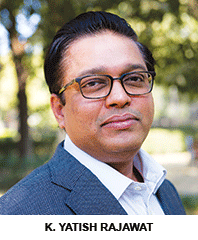 Delhi to Roorkee is almost a five-hour drive passing through Meerut and Muzaffarnagar, cities classified as tier 2 and 3 by soaps and shampoo marketers. The striking feature of the landscape as one crosses Delhi’s outer limits is shiny, glass buildings at regular intervals. A closer look reveals these buildings are colleges and universities. Hundreds of such institutions dot the landscape of India’s crowded highways. At last count, there were 677 universities, 37,204 colleges and 11,443 stand-alone higher education institutions in India.
Delhi to Roorkee is almost a five-hour drive passing through Meerut and Muzaffarnagar, cities classified as tier 2 and 3 by soaps and shampoo marketers. The striking feature of the landscape as one crosses Delhi’s outer limits is shiny, glass buildings at regular intervals. A closer look reveals these buildings are colleges and universities. Hundreds of such institutions dot the landscape of India’s crowded highways. At last count, there were 677 universities, 37,204 colleges and 11,443 stand-alone higher education institutions in India.
The last count was conducted in 2014 by the Union ministry of human resource development (MHRD), and hasn’t been updated since. Tardiness apart, the bigger reason is that a substantial number of these colleges have closed down and universities have collapsed. Actually, higher education in general has collapsed in India, a grim reality absolutely undebated by academics. Their disdain towards their own bailiwick reflects not just apathy, but a dangerous myopia about their future. Higher education in India has reached its dystopia thanks to sub-standard academics.
Consequently, an undergrad degree in India is barely worth the paper it’s written on. There is hardly any real teaching-learning and students don’t acquire any marketable skills. An undergrad degree is merely a stepping stone to a professional postgraduate qualification. Students while away time on college campuses countrywide. Syllabuses are outdated, faculty is inept and ignorant about cataclysmic changes in the real world as most academic appointments in public universities are made by politicians. Private universities also don’t have faculty of any note. Their huge campuses make do with skeletal staff and huge faculty shortages.
This collapse is destroying India’s new aspirational class. A study conducted by the Delhi-based Aspiring Minds, an employability evaluation and certification company, says that 80 percent of engineering graduates are unemployable. If that is alarming, 95 percent of arts, science and commerce graduates are unemployable. What these figures indicate is that the country’s higher education system has collapsed. Nor is there any concern about this decay.
Digital education and skills which would make college/university graduates employable are much in demand these days. The Ireland-based International Computer Driving Licence (ICDL) — a global digital skills certification company — is trying to introduce digital skills in colleges. According to Sayem Mehmood, chief executive of ICDL (India), higher education institutions are lukewarm about skills education and therefore, it’s an uphill exercise to explain the importance of teaching high-end Excel software skills to them. With poor standards endemic to the higher education system, even the country’s famous IITs and IIMs fight shy of digital education.
Indeed, even the IITs and IIMs showcased to the world as successful model institutions, owe their success mainly to the high-calibre students they attract. How many faculty of India’s grandiosely christened Institutes of National Importance have done anything worthy of note? A committee chaired by Dr. Anil Kakodkar, former chairman of the Atomic Energy Commission of India and director of IIT-Delhi, was constituted in 2011 to revamp India’s 30 NITs (National Institutes of Technology). But its brief excluded the country’s numerous engineering colleges and polytechnics. The executive summary of the committee’s report says the NITs have a “major role to play towards national development”. Don’t other engineering colleges and universities with lakhs of students also have to discharge a similar role?
Presented to former HRD minister Smriti Irani in 2014, the Kakodkar Committee’s report is a bundle of homilies, generalities and well-worn advice. “ICT for the NITs acts like a force multiplier. NITs must deploy and upgrade the IT infrastructure and associated facilities. Each institute must facilitate extensive use of computer-aided/online teaching, virtual labs, e-learning resources, connectivity with National Knowledge Network, etc.” This recommendation was made in 2014 at a time when MOOCs (massive open online courses) of MIT-Harvard, Coursera, and free lectures were already being accessed by students in India and around the world. Even the term ICT (information and communications technology) harks back to the 1960s when the committee members were in engineering college.
The plain truth is that India’s higher education system is ossified, dependent as it is on hierarchy and seniority. Higher education cannot be revived or pulled out from the depths of failure by people who don’t have a stake in its future. While we struggle with higher education, Europe seems to be eyeing conscientious Indian students with a rising number travelling abroad for education. Earlier, high cost used to be a formidable barrier to acquiring foreign education. But as our higher education system is collapsing, other countries are offering generous scholarships and inducements.
Acknowledgement of the deep problems embedded within the country’s higher education system is the first step towards finding solutions.
(K. Yatish Rajawat is a Delhi-based digital strategist and policy commentator)